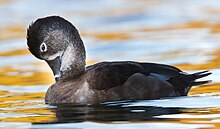Ring-necked Duck
| Ring-necked Duck | |
|---|---|
 | |
| Drake (male) | |
| Conservation status | |
| Scientific classification | |
| Kingdom: | Animalia |
| Phylum: | Chordata |
| Class: | Aves |
| Order: | Anseriformes |
| Family: | Anatidae |
| Subfamily: | Aythyinae |
| Genus: | Aythya |
| Species: | A. collaris |
| Binomial name | |
| Aythya collaris (Donovan, 1809) | |
The Ring-necked Duck (Aythya collaris) is a smaller diving duck from North America.
The adult male is similar in color pattern to the Eurasian Tufted Duck, its relative. It has a grey bill with a white band, a shiny purple head, a white breast, yellow eyes and a dark grey back. The adult female has a pale brown head and body with a dark brown back, a dark bill with a more subtle light band than the male and brown eyes. The cinnamon neck ring is usually difficult to observe, unlike the white ring on its bill, which is why the bird is sometimes referred to as a "ringbill".
Their breeding habitat is wooded lakes or ponds in the northern United States and Canada. They overwinter in southern North America, usually in lakes, ponds, rivers or bays.
These birds feed mainly by diving. They eat aquatic plants as well as some molluscs, aquatic insects and small fish.
The nest is bowl-shaped, built with aquatic vegetation and lined with down, in a dry location near open water. The female lays 8 to 10 eggs and may remain with the young until they are able to fly.
Vagrancy
This strong migrant is a rare but regular vagrant to western Europe. In Britain, occasional small flocks occur, including five at Loch Leven, Scotland in September 2003.In Ireland one or two individuals can be seen at any time of year. Vagrant individuals also occur each year in Central America as far south as Costa Rica between October/November and May/June


No comments:
Post a Comment